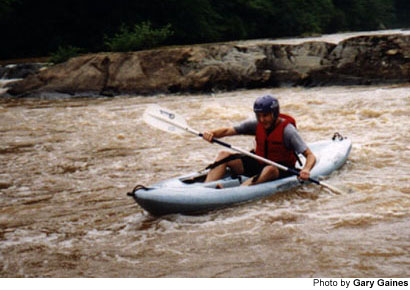
June 29, 1999 — “If you can’t see the river ahead of you, you know you’re in for some fun,” Gary Gaines hollered back at us with a knowing smile.
He then turned his kayak downstream, toward where the Chattahoochee River dropped out of our sight, toward the whitewater that awaited us.
The churning water can’t be seen, but it makes its presence known. Off in the distance, we hear the rumbling of the rapids, a stirring sound sure to make the heart of even the most practiced paddler go pitter-patter.
“You get excited,” said a friend of mine, a fellow novice paddler, after hearing the water’s whispers for the first time. “You don’t really know what to expect down there. But you hear it, and it beckons you to come find out.”
My friend and I eagerly found out what was waiting around each bend. Gaines already knew. The Gainesville resident paddles this four-mile stretch of the Upper Chattahoochee — from the Ga. 115 Bridge to Duncan Bridge — about 50 times a year, and has been at it for more than two decades.
“It’s close by, and it’s beautiful,” said Gaines, 48. “And if you have some decent water in it, it’s still challenging.”
The rains of last week ensured us some decent water, with river levels running about a foot above normal.
Gaines was all smiles when he met us at Wildewood Outfitters, near Duncan Bridge on Ga. 384, about 30-minutes north of Gainesville.
“The water is moving really fast,” he said, grinning.
It’s obvious he loves this stuff. And after a few moments on the hustling ‘Hooch, it’s not difficult to see why.
From our put-in point near the Ga. 115 Bridge, the constant current carried us quickly toward the first set of distant rumblings.
Gaines had time to offer some pointers, most of which detailed what to do if one of our sit-on-top kayaks flipped into the water — an occurrence, it seemed, he believed to be a forgone conclusion this afternoon.
Don’t try to stand up. The rocky river bed has trapped the feet of many a capsized paddler, allowing the violent waters to whip a body around like a rag doll.
Get out of the way of the kayak. Hard plastic is good thing when you run it into a rock, a bad thing when it runs into your head.
And hold onto your paddle. What’s the saying? “Up a creek without a … ”
With the water level as high as it was, paddling was kept to a minimum. It was more a matter of simply keeping the kayaks moving straight. “Aim for the white stuff,” Gaines said.
The rumbling was louder now, and an island was visible in the distance. This marks the beginning of Buck Island Shoals, which offers a relatively continuous quarter-mile stretch of Class II (moderate) rapids.
We headed to the left of the island, and managed to escape the run’s fairly steep, constant drop in gradient unscathed.
We pulled over to the river’s banks. Now it was Gaines’ time to play.
“Watch this,” he said, maneuvering his kayak toward the hydraulic at the base of Buck Island Shoals.
He gently approached the rolling whitewater facing sideways, parallel to the ledge over which the river was flowing. He slid into the wave and traveled back and forth across it. Kayakers call this surfing.
And then he just stopped there, balanced on the line of whitewater. As violent waters continued to rush around him, he stayed there peacefully, leading a delicate dance with nature. It was beautiful.
We continued down the river. More rumblings and a large granite outcropping to the right signaled the next string of whitewater, known as Three Ledges (Class II-III, moderate to difficult).
We again approached from the left. Over the first ledge. Cut a hard right and slide to the left down ledge No. 2. Go straight over the third, and steepest, ledge. Take a deep breath.
Earlier, Gaines had instructed us to fight the urge to hold our paddles above the water in the rougher rapids. “Keep the paddle in the water as much as possible,” he said. “It helps you balance the boat.”
“I think I’m getting the hang of that,” I said shortly after surviving the Three Ledges.
“Good,” answered Gaines. “You’re going to need it down there.”
He was pointing toward the next set of rumblings — the Class II-III Horseshoe Rapid.
Again marked by a large granite outcropping to the right (Mother Nature’s kind way of warning paddlers), the Horseshoe occurs when the ‘Hooch hooks around a long row of rocks.
It’s a quick ride, with a sharp turn … and it’s fun. We carried our boats back over the rocks and did it again.
Things calmed down after that. The Soquee River joins the Chattahoochee just below Horseshoe, and we rode the current to our take-out point at Duncan Bridge.
There we heard the final rumblings of the afternoon. We looked to our stomachs. The whitewaters of the Upper Chattahoochee can make a paddler hungry.
